Introduction to Coordination Chemistry & Types of Ligands | Chemistry Optional Notes for UPSC PDF Download
Introduction to Coordination Chemistry
A complex ion has a metal ion at its center with a number of other molecules or ions surrounding it. These can be considered to be attached to the central ion by coordinate (dative covalent) bonds (in some cases, the bonding is actually more complicated than that. The molecules or ions surrounding the central metal ion are called ligands. Simple ligands include water, ammonia and chloride ions.

What all these have got in common is active lone pairs of electrons in the outer energy level. These are used to form co-ordinate bonds with the metal ion. All ligands are lone pair donors. In other words, all ligands function as Lewis bases.
Bonding in Simple Complex Ions
We are going to look in detail at the bonding in the complex ion formed when water molecules attach themselves to an aluminum ion to give Al(H2O)63+. Start by thinking about the structure of a naked aluminum ion before the water molecules bond to it.
Solved Examples
Example 1: Al(H2O)3+6
Ans: Aluminum has the electronic structure
When it forms an Al3+ ion it loses the 3-level electrons to leave
1s22s22p6
That means that all the 3-level orbitals are now empty. The aluminium uses all six of these empty 3-level orbitals to accept lone pairs from six water molecules. It re-organizes (hybridizes) the 3s, the three 3p, and two of the 3d orbitals to produce six new orbitals all with the same energy.
You might wonder why it chooses to use six orbitals rather than four or eight or whatever. Six is the maximum number of water molecules that will fit around an aluminum ion (and most other metal ions) due to steric constraints. By making the maximum number of bonds, it releases most energy and so becomes most energetically stable.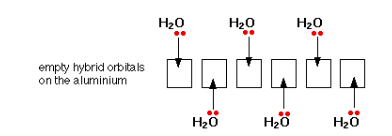
Only one lone pair is shown on each water molecule. The other lone pair is pointing away from the aluminum and so isn't involved in the bonding. The resulting ion looks like this: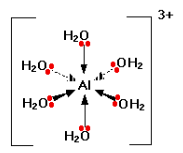
Because of the movement of electrons towards the center of the ion, the 3+ charge is no longer located entirely on the aluminum, but is now spread over the whole of the ion. Because the aluminum is forming 6 bonds, the co-ordination number of the aluminum is said to be 6. The co-ordination number of a complex ion counts the number of co-ordinate bonds being formed by the metal ion at its center.
In a simple case like this, that obviously also counts the number of ligands - but that is not necessarily so, as you will see later. Some ligands can form more than one co-ordinate bond with the metal ion.
Example 2: Fe(H2O)3+6
Ans: Iron has the electronic structure
When it forms an Fe3+ ion it loses the 4s electrons and one of the 3d electrons to leave
Looking at this as electrons-in-boxes, at the bonding level: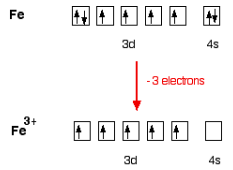 The single electrons in the 3d level are NOT involved in the bonding in any way. Instead, the ion uses 6 orbitals from the 4s, 4p and 4d levels to accept lone pairs from the water molecules. Before they are used, the orbitals are re-organized (hybridized) to produce 6 orbitals of equal energy.
The single electrons in the 3d level are NOT involved in the bonding in any way. Instead, the ion uses 6 orbitals from the 4s, 4p and 4d levels to accept lone pairs from the water molecules. Before they are used, the orbitals are re-organized (hybridized) to produce 6 orbitals of equal energy.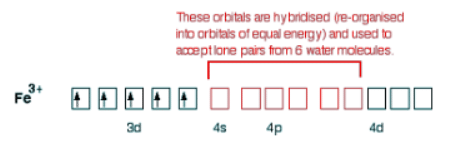 Once the co-ordinate bonds have been formed, the ion looks exactly the same as the equivalent aluminium ion.
Once the co-ordinate bonds have been formed, the ion looks exactly the same as the equivalent aluminium ion.

Because the iron is forming 6 bonds, the co-ordination number of the iron is 6.
Example 3: CuCl2−4
Ans: This is a simple example of the formation of a complex ion with a negative charge.
Copper has the electronic structure
When it forms a Cu2+ ion it loses the 4s electron and one of the 3d electrons to leave
To bond the four chloride ions as ligands, the empty 4s and 4p orbitals are used (in a hybridized form) to accept a lone pair of electrons from each chloride ion. Because chloride ions are bigger than water molecules, you can't fit 6 of them around the central ion - that's why you only use 4.
Only one of the 4 lone pairs on each chloride ion is shown. The other three are pointing away from the copper ion, and aren't involved in the bonding. That gives you the complex ion: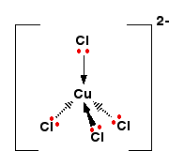 The ion carries 2 negative charges overall. That comes from a combination of the 2 positive charges on the copper ion and the 4 negative charges from the 4 chloride ions. In this case, the co-ordination number of the copper is 4.
The ion carries 2 negative charges overall. That comes from a combination of the 2 positive charges on the copper ion and the 4 negative charges from the 4 chloride ions. In this case, the co-ordination number of the copper is 4.
Bonding in Coordination Complexes
Ligands can be further characterized as monodentate, bidentate, tridentate etc. where the concept of teeth (dent) is introduced. Monodentate ligands bind through only one donor atom. Monodentate means "one-toothed." The halides, phosphines, ammonia and amines seen previously are monodentate ligands. Bidentate ligands bind through two donor sites. Bidentate means "two-toothed." An example of a bidentate ligand is ethylenediamine. It can bind to a metal via two donor atoms at once.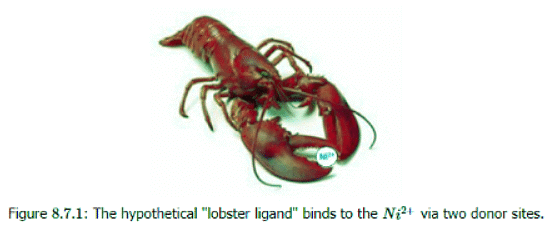 Bidentate binding allows a ligand to bind more tightly. Tridentate ligands, which bind through three donors, can bind even more tightly, and so on. This phenomenon is generally called the "chelate effect." This term comes from the Greek chelos, meaning "crab." A crab does not have any teeth at all, but it does have two claws for tightly holding onto something for a couple of reasons. A very simple analogy is that, if you are holding something with two hands rather than one, you are not as likely to drop it.
Bidentate binding allows a ligand to bind more tightly. Tridentate ligands, which bind through three donors, can bind even more tightly, and so on. This phenomenon is generally called the "chelate effect." This term comes from the Greek chelos, meaning "crab." A crab does not have any teeth at all, but it does have two claws for tightly holding onto something for a couple of reasons. A very simple analogy is that, if you are holding something with two hands rather than one, you are not as likely to drop it.
Complex metal ions containing more complicated ligands
- In the examples previously disccussed, each ligand only forms one bond with the central metal ion to give the complex ion. Such a ligand is said to be unidentate. That means literally that it only has one tooth! It only has one pair of electrons that it can use to bond to the metal - any other lone pairs are pointing in the wrong direction.
- Some ligands, however, have rather more teeth! These are known generally as multidentate or polydentate ligands, but can be broken down into a number of different types.
Bidentate ligands
Bidentate ligands have two lone pairs, both of which can bond to the central metal ion. The two commonly used examples are 1,2-diaminoethane (old name: ethylenediamine - often given the abbreviation "en"), and the ethanedioate ion (old name: oxalate). In the ethanedioate ion, there are lots more lone pairs than the two shown, but these are the only ones we are interested in. You can think of these bidentate ligands rather as if they were a pair of headphones, carrying lone pairs on each of the "ear pieces". These will then fit snuggly around a metal ion.
In the ethanedioate ion, there are lots more lone pairs than the two shown, but these are the only ones we are interested in. You can think of these bidentate ligands rather as if they were a pair of headphones, carrying lone pairs on each of the "ear pieces". These will then fit snuggly around a metal ion.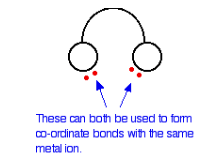
Solved Examples
Example 1: Ni(NH2CH2CH2NH2)2+3
Ans: You might find this abbreviated to [Ni(en)3]2+. The structure of the ion looks like this: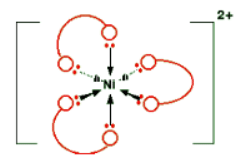
In this case, the "ear pieces" are the nitrogen atoms of the NH2 groups - and the "bit that goes over your head " is the −CH2CH2− group. If you were going to draw this in an exam, you would obviously want to draw it properly - but for learning purposes, drawing all the atoms makes the diagram look unduly complicated!
Notice that the arrangement of the bonds around the central metal ion is exactly the same as it was with the ions with 6 water molecules attached. The only difference is that this time each ligand uses up two of the positions - at right angles to each other.
Because the nickel is forming 6 co-ordinate bonds, the coordination number of this ion is 6, despite the fact that it is only joined to 3 ligands. Coordination number counts the number of bonds, not the number of ligands.
Example 2: Cr(C2O4)3−3
Ans: This is the complex ion formed by attaching 3 ethanedioate (oxalate) ions to a chromium(III) ion. The shape is exactly the same as the previous nickel complex. The only real difference is the number of charges. The original chromium ion carried 3+ charges, and each ethanedioate ion carried -2, i.e.,
(+3) + (3 × −2) = −3.
The structure of the ion looks like this: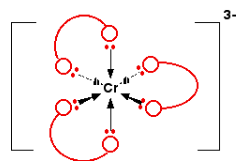
A Quadridentate Ligand
A quadridentate ligand has four lone pairs, all of which can bond to the central metal ion. An example of this occurs in haemoglobin (American: hemoglobin). The functional part of this is an iron(II) ion surrounded by a complicated molecule called heme. This is a sort of hollow ring of carbon and hydrogen atoms, at the center of which are 4 nitrogen atoms with lone pairs on them. Heme is one of a group of similar compounds called porphyrins. They all have the same sort of ring system, but with different groups attached to the outside of the ring. You aren't going to need to know the exact structure of the haem at this level.
We could simplify the heme with the trapped iron ion as: Each of the lone pairs on the nitrogen can form a co-ordinate bond with the iron(II) ion - holding it at the center of the complicated ring of atoms. The iron forms 4 co-ordinate bonds with the heme, but still has space to form two more - one above and one below the plane of the ring. The protein globin attaches to one of these positions using a lone pair on one of the nitrogens in one of its amino acids. The interesting bit is the other position.
Each of the lone pairs on the nitrogen can form a co-ordinate bond with the iron(II) ion - holding it at the center of the complicated ring of atoms. The iron forms 4 co-ordinate bonds with the heme, but still has space to form two more - one above and one below the plane of the ring. The protein globin attaches to one of these positions using a lone pair on one of the nitrogens in one of its amino acids. The interesting bit is the other position.
The water molecule which is bonded to the bottom position in the diagram is easily replaced by an oxygen molecule (again via a lone pair on one of the oxygens in O2) - and this is how oxygen gets carried around the blood by the haemoglobin. When the oxygen gets to where it is needed, it breaks away from the haemoglobin which returns to the lungs to get some more.
Carbon Monoxide Poisoning
You probably know that carbon monoxide is poisonous because it reacts with hemeoglobin. It bonds to the same site that would otherwise be used by the oxygen - but it forms a very stable complex. The carbon monoxide doesn't break away again, and that makes that hemeoglobin molecule useless for any further oxygen transfer.
A Hexadentate Ligand
A hexadentate ligand has 6 lone pairs of electrons - all of which can form co-ordinate bonds with the same metal ion. The best example is EDTA. The diagram shows the structure of the ion with the important atoms and lone pairs picked out. The EDTA ion entirely wraps up a metal ion using all 6 of the positions that we have seen before. The co-ordination number is again 6 because of the 6 co-ordinate bonds being formed by the central metal ion. The diagram below shows this happening with a copper(II) ion. Here is a simplified version. Make sure that you can see how this relates to the full structure above.
The EDTA ion entirely wraps up a metal ion using all 6 of the positions that we have seen before. The co-ordination number is again 6 because of the 6 co-ordinate bonds being formed by the central metal ion. The diagram below shows this happening with a copper(II) ion. Here is a simplified version. Make sure that you can see how this relates to the full structure above.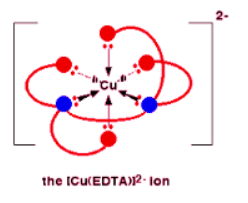
The overall charge, of course, comes from the 2+ on the original copper(II) ion and the 4- on the EDTA4− ion.
FAQs on Introduction to Coordination Chemistry & Types of Ligands - Chemistry Optional Notes for UPSC
| 1. What is coordination chemistry? |  |
| 2. What are ligands in coordination chemistry? |  |
| 3. What are bidentate ligands? |  |
| 4. What is a quadridentate ligand? |  |
| 5. What is a hexadentate ligand? |  |
















